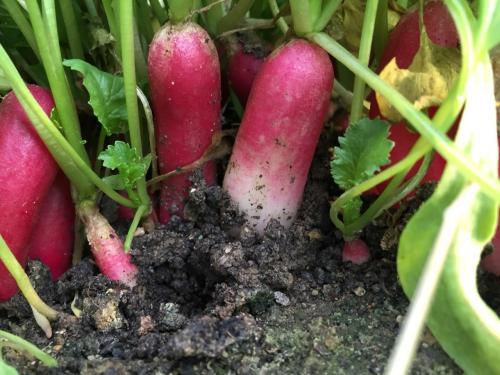Flint, Michigan area urban agriculture report – May 6, 2015
Temperatures, updates and concerns about urban agriculture in the Flint area.

Weather
According to the Michigan State University Enviro-weather station in Flint, Michigan, temperatures for the past week ranged from a 37.7 degrees Fahrenheit low to an 79.8 F high (last Sunday). We are at 169 GDD base 50 (Growing Degree Days); this past week’s warmth has brought our season back to near normal. The rainfall total for the year to date in Flint is 3.61 inches; we are still over an inch behind in average rainfall at this point in our growing season.
Crop reports
According to research done in the MSU Hoop-houses located at the Student Organic Farm and educator observations from the field, warm season crops are being planted and cool season crops are being harvested due to season extension technology at this time of year. Resources available on the MSU Hoop-house website include general information, crop schedules, business planning information, transplant information and funding opportunities for hoop-house growers. In area hoop-houses, planting of warm season crops such as tomatoes, peppers and cucumbers continues.
One grower reports flea beetles in the hoop-house, which damage plants by chewing small shot-holes in the foliage, and can be a serious pest in the production of leafy vegetables. The cabbage flea beetles primarily attach cabbage family plants, which include many of the cool season crops (broccoli, cabbage, kale, Brussels sprouts, radish) being planted and grown at this time of the year. The use of floating row covers to exclude the beetles from susceptible crops is one barrier tool our small scale growers employ. One grower reports that this past week’s warm weather is causing many salad greens crops to bolt in hoop-houses, so they are being removed as it renders the crop unmarketable. Bolting is a term that refers to a plant’s process of sending up a flower stalk, or going to seed, in response to either day length or temperature. In this past week’s case, it was the salad greens exposure to hot weather. In another grower’s hoop house this week, we’ve discovered what we think is variegated cutworm damage in several beds of pepper transplants.
In outdoor fields, growers are continuing to plant cool season vegetables like beets, fennel, parsnips, carrots, kale, peas, scallions and radish.
Going to area farmers markets now
 According to a Michigan State University Extension food systems educator, area growers are harvesting scallions, herbs (chives, oregano and thyme), salad mix, spinach and radishes from area hoop-houses this week. For some small scale growers, this past week’s upswing in temperatures and the effect it had on their salad greens crop causes a short term challenge to have enough continuous crops to take to market, as the outside greens aren’t quite big enough to harvest yet.
According to a Michigan State University Extension food systems educator, area growers are harvesting scallions, herbs (chives, oregano and thyme), salad mix, spinach and radishes from area hoop-houses this week. For some small scale growers, this past week’s upswing in temperatures and the effect it had on their salad greens crop causes a short term challenge to have enough continuous crops to take to market, as the outside greens aren’t quite big enough to harvest yet.
For helpful information on how to select, prepare, and safely preserve Michigan’s bounty of fresh, locally grown vegetables, fruits, ornamentals, meats, eggs, nuts and fish, check out the Michigan State University Extension Michigan Fresh program. There you will find current fact sheets on over 50 crops, general food and ornamental gardening information, food preservation information, recipe cards, a seasonal harvest availability guide and a guide for donating fresh produce.



 Print
Print Email
Email



